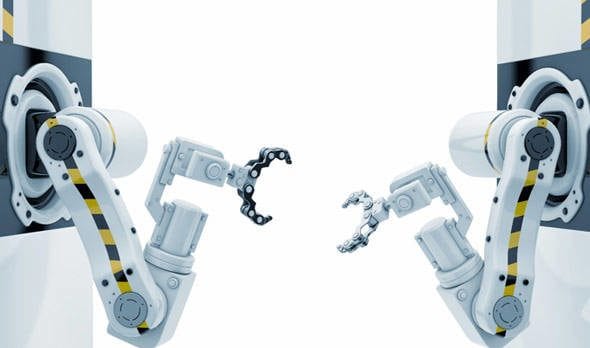A Renewal Strategy Towards Truly Digital Banking
By Puneet Chhahira, Global Marketing Lead – Infosys Finacle

Positioning is the art of creating a distinct and unique identity vis-a-vis the competition in the consumer’s mind. But in at least some new-age digital-only banks, positioning isn’t about differentiating from the traditional bank at all. On the contrary, the emphasis is on not being a bank, at least not in the conventional sense of the term. Think, Simple, the self-proclaimed anti-bank, and Atom, the bank that claims it won’t ‘act like a bank at all’.
This isn’t merely clever branding, it’s also about distancing the new-age bank from the legacy trappings of the old. It’s a message that resonates strongly with future banking customers, such as millennials, many of whom believe that tech startups will drive banking innovation and make better financial services providers than conventional banks.
Legacy, a huge source of challenge for conventional banks
It is ironic that IT systems, a bank’s biggest enabler, are today its biggest barrier to innovation. Built in the days of product-centric banking, IT applications were architected to run processes for each product from end to end. This created rampant duplication of applications and processes across product lines.
The problems were compounded with channel proliferation, which required the integration of channel-specific interfaces to product-centric architectures. The sudden shift to customer-centricity forced a series of tactically appropriate decisions and discrete integrations that only worsened an already chaotic situation. Large banks, in particular, have taken a big hit to agility, flexibility and innovation capability.
All this is not only preventing banks from performing to potential but also from exploiting the power of new digital technologies to the fullest. So, does that mean established banks, with their legacy, can never turn truly digital? Or that new banks that have no legacy, automatically are? No, not at all. At Infosys Finacle we believe that there’s a lot more to the truly digital bank, a point of view that is shared here.
The four hallmarks of a truly digital bank
- The customer is the focal point
Customers are no longer just passive consumers of financial services. Digitally empowered, they are taking control of their banking relationships and financial decisions, and expect that their banks will help them achieve their goals effectively and efficiently. With customers becoming more demanding, assertive and influential in the relationship, banking experience is becoming the kingmaker in this business. Hence every aspect, including processes, strategies and decisions, must reflect this priority.
The truly digital bank will find ways to innovate regular products and processes to make them customer-centric. Fintech startup Digit and Commonwealth Bank exemplify this: Digit offers an app-less service that analyzes customers’ spending based on which it withdraws small amounts to put into a fixed deposit. Incidentally, this type of product – a Flexi Fixed Deposit – has been offered by many of our clients for several years now. Commonwealth Bank has made the mortgage process more customer-centric with its property guide mobile app, which allows prospective home buyers to just “scan” a property and instantly receive data on ruling price, sales history, suburb profile, rental yield etc. This gives the bank an opportunity to engage with customers early on in the mortgage engagement cycle.

Offering services to cater to customers’ growing preference for social banking on Facebook, Twitter etc. is one way to bring customer-centricity to channels. However, today’s digitally-empowered customers demand customer-specificity where the focus shifts from addressing identical individuality to recognizing individual identity. Banking solutions will have to be tailored to ‘segment of one’ circumstances, like Alpha Bank’s wearables-linked savings account that rewards customers for an active lifestyle.
In a truly digital banking scenario, technologies like gamification and augmented reality will be leveraged to encourage desired behaviors and improve the experience. Banks will look to collaborate and co-create to come up with the best, most customer-centric ideas. Importantly, banks will not only look at the needs of their own customers, but also their customers’ customers. Once again, Commonwealth Bank serves as a great example. The bank has launched the Albert App for merchant point of sale terminals, which is revolutionizing the payment experience for cardholders. What’s more the App can be used to customize the interface for different businesses. In restaurants, for instance, the interface can be designed to allow a group to view the bill, split it up, get the individuals to pay their share including tip, discreetly and without any intervention by restaurant staff. This has really improved the experience for all concerned.
In Poland, the ever innovative Idea Bank (even its name is appropriate!), the winner of BAI – Infosys Finacle Global Banking Innovation Awards 2015, is offering cash management services to SME clients that enable them to order a multi-function mobile ATM at no additional charge. A dedicated mobile app, developed in cooperation with iTaxi is behind this facility. Clients can call the nearest vehicle and monitor its position on a map with a real-time tracking system. Once it arrives, the customers can complete their cash management operations within minutes.
No doubt banks have made efforts to become more customer-centric over the years. But now there’s a need to step up the pace of change, as well as broaden its area of impact, starting with the business model. Hence, when drawing up their business plans, banks should focus on customer value and experience as a primary goal, rather than an afterthought to cost and revenue targets.
- Insight is everything
Banks always had a wealth of customer data, which has multiplied manifold in the digital paradigm. The ability to quickly capture and convert data in near- or real-time into actionable insights will distinguish the digitally-enabled from the truly digital. With the help of advanced analytics technologies, banks can now leverage the treasure trove of information, both within and outside the enterprise, to gain granular, real-time insights into customers, operations, markets and more.
Apart from the transaction and behavioral data, banks also have access to a variety of external data sources from social channels that enable them to segment customers on the basis of individual values, expectations and needs, rather than by broad demographics. Using the power of analytics banks can now build richer insights into individual customers’ life stage circumstances and personalize the banking experience to the ‘segment of one’. From the customer’s perspective, this will manifest as more personalized, contextualized and relevant products and services. Truly digital banks will leverage insights to stay ahead and educate clients proactively about their emerging needs – even before the customer has fully recognized them.

Insights drawn from the advanced analytics will also be critical to reduce the cyber-risks and contain frauds. Truly digital banks will also leverage data-driven insights to optimize operations to reduce costs. For instance, banks can leverage the insights to optimally staff their call centers during the holiday season. Many of our clients are leveraging insights to decide upon the location for their ATMs. Digital banks will also leverage insights to identify opportunities for revenue expansion ahead of others. For instance, reaching out to unhappy customers of other banks with contextual offers.
To imbibe the full potential of analytics into the organization, truly digital banks would need to leverage cloud-based/open source technologies. In addition, they must make efforts to democratize analytics and integrate it into the experience of all stakeholders, from customers and all types of staff – not just senior executives – to suppliers and partners.
- Automation drives experience
The rise of digital banking has created an explosion in transaction volumes. For a truly digital bank, automation is a critical prerequisite both for delivering a frictionless experience at the customer interface and streamlined operations at the back-end. Automation, driven by business rules, algorithms and machine learning, will give banks the operational leverage to process millions of transactions and thousands of loans every day without increasing costs. It will also allow them to accelerate the pace at which they acquire new customers and expand their business. Automation will also free up the workforce from mundane repetitive tasks to allow them to focus on higher value generating activities.

But that’s only the beginning. The truly digital bank has to exist in a world of autonomous businesses driven by the Internet of Everything and smart machines, which has several implications. For instance, autonomous cars and sharing culture stimulated by providers like Uber are expected to reduce the number of cars per household significantly in future. Banks need to understand how this would impact their motor loan business. When refrigerators and kitchen containers order groceries on their own, banks must have a way of engaging with those gadgets. Even more importantly, they must prepare to engage and influence intelligent machines like Avatars, Robo-advisors and Automated Investment Platforms that will help clients take decisions in future.
With more data, more compute and better algorithms driving smart automation on the one hand, and emerging technologies like Blockchain pointing at the automation of clearing, settlement and reconciliation on the other, the truly digital bank will need to create the necessary capabilities to help it sustain in its fully digital environment.
- Collaborative ecosystem is the new universal bank
The digital paradigm distributes, decentralizes and disintermediates. Hence truly digital banking will be built not on individual universal banks, but on an ecosystem of providers who will together deliver best-in-class experiences. The focus, therefore, will have to be on building systems of collaboration that can create a constantly expanding ecosystem that can deliver all services relevant to a customer’s financial needs in a seamless manner. Accordingly, the ecosystem needs to include partners from the financial and non-financial industries.
Such an ecosystem will give banks the ability to create interfaces with other auxiliary networks and services that can enable them to extend the reach of their core business functionality as well as quickly add new competencies. Banks will become more open, thanks to APIs, apps and developer/partner ecosystems. Co-operation and Co-opetition will continue to increase. Already, we are seeing examples, such as Semble, a collaborative project between three mobile operators – Vodafone, 2degrees and Spark – and ASB and BNZ banks, to create New Zealand’s first mobile wallet.

One of the biggest challenges to creating collaborative interfaces has been the legacy applications and the risk involved in granting access to banks’ core information resources. But banks can now address that challenge by deploying modern componentized, APIs led applications, to decouple front-end services from back-end resources. This means banks are now empowered to develop collaborative ecosystems that expand access and accelerate innovation at the edge of the enterprise without compromising the security of core resources.
Increasing collaboration and openness are not only a business imperative; going ahead even regulators are going to demand this of banks. For instance, Europe has proposed the PSD 2 initiative mandating banks to open up payments APIs to enable other providers to easily consume such services. Progressive banks aren’t waiting until such a day. They are embracing open banking to proactively curate the ecosystem of service providers around them. They understand that the ecosystem will be the new universal bank in the digital era.
This broad framework makes it quite clear that wrapping an old business model in the latest digital technologies, or giving legacy processes a digital facelift, is not going to create a truly digital bank. In order to become truly digital, traditional banks need to take a holistic approach to digitalization that will transform them in entirety – from the structures that define their purpose to the processes and systems that power their business.
However, digital banks will face a serious challenge in the form of the increasing cyber-attacks. With touch-points increasing, and banks opening up to partners and external ecosystems, the need to secure their systems against digital attack has never been greater. Unfortunately, most banks are ill prepared to face this threat, as evidenced by incidents like the cyber-attack on RBS online services and the JP Morgan data breach and so many others like it. Banks need to secure themselves by staying compliant with an ever-expanding repertoire of risk management best practices, and also by developing an understanding of yet to emerge risks, such as that of fraud scenarios in distributed ledgers. Banks need to create a strong foundation of agile systems and processes and an environment of continuous innovation, to manage the challenges and exploit never-before opportunities for growth in the digital era.
And that is something that all our progressive clients understand. They have no misconceptions that cosmetic digitalization will be enough to address either the exacting expectations of today’s digital customers or the heightened threat of digital-only competition. Rather, they acknowledge the need to digitalize the enterprise holistically. Capabilities built on modern technology will lay the foundation for this transformation. Today Infosys Finacle is helping many of these organizations do just that with a dual strategy of “Renew and New” – because it is necessary to renew the existing landscape of legacy systems to make it ready to exploit the new technologies that are central to a truly digital bank.
Renew and New: Infosys Finacle’s recommended path to truly digital banking
Clearly, the truly digital banking experience requires a transformation that impacts almost every aspect of the enterprise. The good news is that the fundamentals finally seem to be aligning up to favor this. In 2015, the global GDP is expected to grow at 3.5 %, a small yet important improvement over the last year. The global banking sector also seems to have finally come out of its extended recovery phase. Therefore, the time is ripe to launch a transformation exercise.
To our clients, we recommend the dual strategy of ‘Renew and New’, built on the bedrock of unified purpose, innovation and creativity. The strategy calls for banks to upgrade and deploy modern systems that allow them to tap into the benefits of new technologies such as mobility, analytics, cloud computing, block chain, and artificial intelligence to gain agility to respond effectively to the evolving environment. At the same time, banks also need to leverage these new technologies to open green-field opportunities for growth, profitability and enhancing the consumer experience.
Balance is key to the Renew and New strategy. While banking leaders everywhere are eager to add new digital capabilities that will open up new opportunities, they have to also ensure their existing systems, processes and applications are capable of absorbing and supporting such capabilities. A linear approach, which prioritizes one over the other, will fail to deliver to expectations. Focusing entirely on adding digital capabilities at the customer interface without connecting them back to the core would create a short-term tactical advantage at best. On the other hand, re-engineering the core without adequately re-imagining processes and digitalizing customer-facing systems will severely impede innovation in the enterprise.
The beauty of the Renew and New strategy is in its ability to adapt itself to the specific circumstances of each bank’s digital transformation needs. Every bank has a unique IT transformation agenda derived from the technological and architectural profile of its systems, business priorities, among others. At Infosys Finacle, we have successfully applied our dual strategy to banks of diverse sizes, in different stages of technological evolution, and with distinctive priorities. Here are a few examples of this from our client organizations.
Powering all-round innovation at India’s largest private sector bank
ICICI Bank, India’s largest private sector bank, has been a torchbearer for technology-leveraged innovation and a pioneer of many industry-first innovations in the past decade. In the process, it has managed explosive growth in customer base and business. The bank has grown the business from a customer base of 2 million in 2001 to over 56 million today; from 110 branches to over 4050 branches and reaching an asset size of over US$ 103 billion with over US$ 9.8 billion $ in revenue. The Finacle platform has played a key role in enabling many of the bank’s breakthrough innovations.
Riding on the sound technology foundation of multichannel capabilities offered by Finacle Core Banking, and Finacle e-banking solution, the bank has pioneered many industry-first innovations in the past decade such as Flexi-fixed deposits, Goal based flexi-recurring deposits, Facebook Banking, Direct Banking, and Tablet Banking.
ICICI Bank realized that to continue to win in the newly digitized environment, it needed to leverage the latest in digital technology, and modernize both core banking and digital channels. The bank kicked off 2015 with the renewal of its core banking system by deploying Finacle version 10 to serve its customer base of over 56 million with real-time, customer-centric experience. This was quickly followed by the launch of Pockets, India’s first digital wallet that enables users, including non-ICICI customers, to transact on any website or mobile application in India. Mere months later the bank launched iWear, the country’s first multi-platform smartwatch app that lets ICICI customers stay connected with their bank accounts at all times.
Progressive modernization for a leading U.S. direct bank
The application and associated benefits of the dual strategy of renew and new are not limited to the traditional banks. We are also working with new-age direct banks to accelerate their journey towards delivering truly digital banking. One of our clients, Discover Financial Services (DFS) is a direct bank in the U.S. with just one branch, but a presence across all fifty states. It is the thirty-third largest bank holding company in the country, with total assets of $80.6 billion.
DFS had a complex legacy IT environment supporting over 100 discrete IT services, 75 of which required point-to-point integration. Many of these services were also being used from hosted system providers.
We partnered DFS to implement a program of progressive renewal and modernization that would help minimize risks and accelerate business benefits faster. Considering the bank’s pan-U.S. presence, compliance with all Federal and State laws was also a critical requirement of the transformation.
Since the transformation of the deposit business, in the first phase, DFS has achieved significant acceleration in many of its key business processes. The account opening process has been reduced from twenty steps to six and customer requests are now being processed with 40% fewer clicks. Account servicing costs have also dropped by 65% while interfaces for customer service agents have gone from 20 to an incredible figure of 1. Compliance requirements have also been completely automated thus significantly reducing the risk of non-compliance.
Following the successful modernization of its deposits business, DFS is now working with Infosys Finacle to transform its loans portfolio.
Multi-country commercial banking transformation for a global financial powerhouse
Commercial Banking modernization is one of the most ambitious programs at The ING Group, a true tier 1 global financial institution. In 2013, ING in partnership with Infosys Finacle, embarked on a massive exercise to transform its commercial banking operations in 28 countries spread across three continents.
Like most large banks, the technology landscape at ING featured multiple legacy components that not only impeded scalability but also drove up maintenance costs. The general lack of standardization also created multiple operational challenges for the bank, including drawn-out time-to-market for new product launches. ING wanted to standardize all offerings and solutions around the key program objectives of maximizing customer-centricity and operational efficiency. The plan is to leverage the robust account management modules and the multi-entity feature of Finacle to unify multi-country operations under one entity with a unified database.
The early results of the transformation, with the first country, Ireland, going live on Finacle, have been highly encouraging. The time-to-market for new and innovative commercial banking products has been reduced to weeks from the months it took with the previous legacy systems. The account opening process now takes ten minutes instead of two days. The new Global Account Management System also opens up the opportunity for ING to offer new services, like white label and intraday liquidity services, to its corporate and institutional customers.
Multi-entity, big bang transformation towards growth and profitability
Our client, Rizal Commercial Banking Corporation (RCBC) is the fourth largest bank in the Philippines with over 400 Branches, 3,000 users and 6 million accounts. Its subsidiaries include RCBC Savings Bank for thrift banking, RCBC Capital for investment banking services, Bankard, Inc. for credit card issuance, RCBC Forex for currency trading, and RCBC Securities, Inc. for brokerage services.
In 2012, RCBC started Project Destiny, carrying through an upgrade of its system with Finacle’s solution suite across commercial banking and thrift banking subsidiaries. RCBC upgraded 96 application systems, redefining 291 processes, reconfiguring over 400 branches, and migrating 3.5 million customers simultaneously in all its branches, and head office units as well as in its subsidiary, RCBC Savings Bank. The results have been outstanding and offer a great example of how renewal of business can create a great foundation for new innovations, growth and profitability.
Without any staff additions, the bank was able to achieve a nearly 25% increase in loan processing volumes and a 300% increase in Internet banking transactions through enhanced automation. The cost of teller-based transactions went down by 10% even as teller productivity increased 33%. Straight through processing and automation also delivered cost savings of 25%.
RCBC realized a 54% return on transformation investments during the first year with benefits expected to go up to 2.1 billion Peso by the fifth year of deployment. The bank has also received multiple awards for the program including the Asian Banker award for best implementation and the Celent Model Bank award. The bank’s CIO, Mr. Dennis Bancod was also named the Most Outstanding ASEAN CIO in 2013.
Creating a new multi-country direct banking model
When one of our clients, Raiffeisen Bank International, took the decision to target digital customers, they launched a completely new entity called ZUNO Direct Bank. With this, they created a unique multi-country direct banking model.
Finacle played a strategic role in supporting ZUNO’s ambitions to expand its geographic footprint as well as its product portfolio. The bank was launched in Slovakia at the end of 2010 with an initial portfolio of deposit products, including current accounts and debit cards. In July 2011, it expanded into the Czech Republic and also successfully added a new lending product portfolio, including personal retail loans and overdraft lines.
ZUNO has since grown into a multi-country direct bank with a customer portfolio of more than 250,000 customers. The bank plans to further expand its product portfolio and as well as enter new markets in future.
Becoming truly digital
Most banks understand the need and the importance of becoming truly digital and the role this will play in the success of their business aspirations. But legacy challenges, especially at large banks, have thus far slowed down the transition to a truly digital banking model. Even as banks accelerate the deployment of new digital capabilities at the edge of the enterprise they have been largely unable to achieve a proportional pace in digitalizing the core. And unless they are able to accomplish a perfect alignment of their digital capabilities from the core to the customer interface, they will not be able to realize the delivery of truly digital banking. The emphasis, therefore, has to be on an orchestrated strategy that drives renewal from the core outward even as it enables the effective assimilation of new digital technologies from the edge.
Infosys Finacle’s strategic “New and Renew” model is designed to help banks achieve that orchestration while simultaneously accelerating digital transformation, minimizing business risk and expediting business benefits. This dual strategy will enable them to add new capabilities critical for pursuing greenfield opportunities as well as re-energize existing systems, processes and policies with emerging technologies. The approach should be to build on existing strengths of scale, reputation, brand, trust and customer relationship, and in parallel, experiment with new technologies, innovations and business models befitting the digital age. Along the way, there will be trial and failure, innovation and success, improvement and iteration, all as necessary as they are unavoidable.